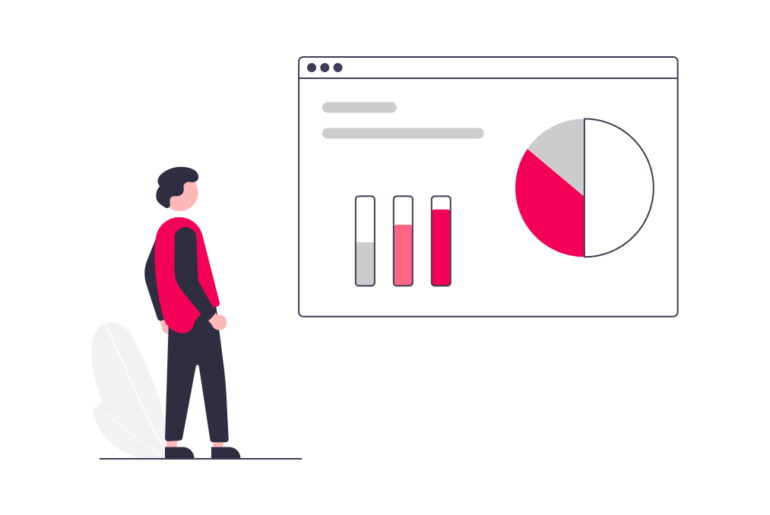A niche industry like programmatic advertising has its own set of terminologies, which can be confusing to many. Even publishers tend to use eCPM and CPM interchangeably while evaluating their ad inventory. But what is eCPM vs CPM? Let’s find out!
In the sphere of programmatic advertising, many parameters come into play when deciding the success of an ad campaign. One is CPM, and the other one is eCPM, with eCPM as a publisher metric and CPM as an advertiser metric.
As programmatic advertising continues to grow, understanding these metrics is crucial. In fact, according to eMarketer, programmatic advertising spending in the US will touch USD 180 billion in 2025.
But how does it matter? Which one is more beneficial? What is eCPM vs CPM? We will address all these questions in this blog.
What is eCPM vs CPM?
eCPM and CPM are the monetization metrics that publishers and advertisers use to gauge their revenue generation potential and compare costs across various ad campaigns, respectively. As a publisher, you need to be well-versed with both terminologies within programmatic advertising to reap the full benefits of your ad inventory.
Advertisers use CPM to target relevant audiences, increase the visibility of their ad campaigns, and optimize them accordingly. On the other hand, publishers use eCPM in advertising for ad revenue optimization and compare inventory effectiveness across their digital assets.
Let’s get into eCPM vs CPM in detail and understand how the two metrics can be beneficial for you as a publisher.
What is eCPM? (eCPM Meaning)
eCPM stands for Effective Cost Per Mille. As mentioned earlier, eCPM is a monetizing metric used by publishers to know the revenue generated per thousand advert impressions.
Trivia: Mille is the Latin word for Thousand.
Here, effective is the word you should emphasize. It means the effective revenue earned by the publisher per 1000 impressions sold to the advertiser, whether the ad gets clicked or not. Apart from CPM, eCPM is also determined using CPC, CPL, and other campaigns that use the publisher’s inventory.
There are two terms a publisher should be aware of regarding eCPM:
- eCPM Floor: It is the minimum price set by the publisher per thousand impressions to display ads on their website. Advertisers placing their bids below the eCPM floor price won’t be able to show their ads on that publisher’s website.
- eCPM for Ads: App developers use eCPM to compare ad revenue across various platforms using multiple factors like location, demographics, etc., to determine which ad unit makes the most profit.
How to Calculate eCPM? (eCPM Formula)

eCPM Example
For example, a publisher earned USD 2500 for 850,000 impressions. Then, the eCPM will be:
(2500/850,000)*1000 = $2.94
Hence, the publisher earned USD 2.94 per thousand impressions.
Now, let’s look at what CPM is.
What is CPM? (CPM Meaning)
CPM stands for Cost Per Mille. It means the cost incurred by a marketer for every thousand impressions sold to them by the publisher. It’s an important metric for advertisers to decide their budget for ad campaigns across platforms. CPM helps the advertiser decide which platform will receive what percentage of the total advertising budget.
How to Calculate CPM? (CPM Formula)
CPM Example
For example, an advertiser with a budget of USD 5000 bought 1,500,000 impressions from various publishers. Then, the CPM will be:
(5000/1,500,000)*1000 = $3.33
Hence, the advertiser spent USD 3.33 per thousand impressions. This means that any publisher offering ad impressions equal to or below USD 3.33 would be able to display this advertiser’s ads.
Now that we have laid out the basics of eCPM and CPM, let’s get on to the eCPM vs. CPM stand-off.
eCPM vs CPM: Key Differences
| Aspect | eCPM | CPM |
| Full Form | Effective Cost Per Mille or Effective Cost Per 1000 Impressions | Cost Per Mille or Cost Per 1000 Impressions |
| Used By | Publishers | Advertisers |
| Formula | (Total ad revenue earned / Total ad impressions) * 1000 | (Total ad campaign budget / Total ad impressions) * 1000 |
| Measurement Focus | Revenue per thousand impressions, reflecting the effectiveness of ad units across different pricing models. | Cost of acquiring a thousand impressions, reflecting the advertiser’s budget for ad placement. |
| Scope | Takes into account revenue from various pricing models (CPC, CPL, etc.), giving a broader view of ad performance. | Specific to CPM ad buying model, focusing on the cost of impressions. |
| Impact on Revenue | Higher eCPM indicates higher revenue per impression, leading to increased total revenue for publishers. | Higher CPM indicates higher cost per thousand impressions, which doesn’t necessarily equate to higher revenue. |
| Publisher Focus | Measures the effectiveness of ads in driving conversions and overall revenue. | Measures the cost efficiency of ad placement in reaching target impressions. |
| Advertiser Focus | Useful for understanding the total revenue generated by campaigns and optimizing ad placement based on performance. | Used to evaluate the cost of ad impressions and compare ad placement costs across different publishers. |
Simple Breakdown of eCPM and CPM Calculation
Lets look at an eCPM vs CPM example to understand the concept better. You are a shopkeeper who sells lemon juice. At present, you have 5 liters of lemon juice, or 20 glasses in your stock (ad inventory). Each glass of lemon juice represents 10,000 impressions. In total, you have 200,000 ad impressions to sell.
Now, as lemon juice is a perishable item, you will need to sell them as quickly as possible.
In the first half of the day, you sell 16 glasses (160,000 impressions) for $2 CPM price. This gives you an ad revenue of USD $320. You sell 3 glasses in the evening for a CPM price of $1.5, generating an ad revenue of USD 45.
Unfortunately, a fly dropped in the last glass, so you couldn’t sell it. In total, you sold 19 glasses for USD 365 (320+45).
So, your eCPM would be the total revenue generated divided by the number of impressions sold multiplied by one thousand.
eCPM = 365/190,000*1000 = $1.92
Keep in mind that the eCPM calculated here is only for the 19 glasses or 190,000 impressions you sold. Hence, you have earned $1.92 per thousand impressions.
How to Derive eCPM from CPM?
We will be taking another example to understand how, as a publisher, you can convert an advertiser’s metric to a publisher’s metric.
Let’s keep the above example to maintain uniformity in our understanding. You are a publisher with ten ad slots and got connected to an advertiser through an ad exchange.
The advertiser is offering you a guaranteed deal of buying your 100,000 impressions for USD 500. So, the CPM price will be (500/100,000)*1000 = $5 CPM rate.
But as you are getting this deal through an ad exchange, you won’t be getting the full amount. The platform will be deducting a certain amount as their fees, let’s say 10% ($50). Accordingly, you will be earning 500-50 = USD 450 for 100,000 impressions.
Going by this, your eCPM should be USD (450/100,000)*1000 = $4.5.
While the advertiser paid a $5 CPM rate, the amount you would be receiving as a publisher would be $4.5. Hence, one should make sure that eCPM and CPM are not used interchangeably. Keep this variation in mind while negotiating direct deals.
How is Effective CPM (eCPM) Important for Publishers?
eCPM is a core metric used by publishers to judge the quality of their ad inventory. Apart from that, it also helps in comparing website performance and setting floor prices, among other things. Other benefits include:
- Comparing ad inventory performance across different platforms operated by a publisher (websites, YouTube channels, Social Media, etc).
- Comparing ad space performance across web pages of a single website.
- Drawing eCPMs from various ad partners/platforms to compare ad performance.
- Adjusting floor prices according to the market demand by comparing monthly or quarterly eCPMs.
- Ideal revenue metric even for publishers selling ad slots based on clicks, purchases, subscriptions, or any other visitor action (direct-response campaign).
How is CPM Important for Publishers?
Although used by advertisers, publishers can also use CPM as a revenue-generating metric for:
- Getting to know the advertiser’s metrics during direct deals to negotiate a favoring deal.
- Narrowing down campaign goals for publishers if they are solely looking to earn via impressions (in this case, increase website traffic).
- Reach out to advertisers spending the most on your ad inventory and negotiate a fair deal by showing a comparison of bids placed by other advertisers.
- Locating geographics that earn high CPM to create more targeted content for the audience.
CPM vs eCPM: Key Takeaways
- CPM and eCPM are two important ad performance metrics used by publishers and advertisers alike to gauge the success of ad campaigns (advertisers) and ad inventory’s effectiveness (publishers).
- eCPM is the ad revenue generated by a publisher per 1000 ad impressions, while CPM is the price paid by an advertiser for every 1000 impressions.
- eCPM is used by publishers for various purposes, such as comparing ad space across different digital assets, setting floor eCPM, and comparing ad partners.
- Advertisers use CPM to optimize their ad campaigns, increase brand visibility, and generate leads, among other things.
- Two ad units can have the same CPM but varied eCPM based on relevance, different levels of targeting, or higher click-through rates (CTR).
Does your monthly revenue touch $5000? If yes, then get ready to increase your ad revenue by 30%? Contact AdPushup today and let your revenue touch new heights.
Frequently Asked Questions
eCPM is an important ad performance indicator used by publishers to monitor the money earned from the adverts on their websites.
eCPM is a publisher-side metric that calculates the revenue generated per thousand impressions, while CPM is an advertiser-side metric that calculates ad spend per thousand impressions.
eCPM stands for Effective Cost Per Mille (Thousand). It means ad revenue generated by the publisher for every thousand impressions. Mille is the Latin, Italian and French word for thousand.
eCPM is calculated using the following formula:
eCPM = (Total revenue generated/Total impressions)x1000
In simple words, by dividing the total revenue generated by total impressions and multiplying the figure by a thousand, you get eCPM.
eCPM is the revenue earned by a publisher from various advertising platforms using their ad space. On the other hand, RPM, or revenue per mille, is a monetization metric that calculates the publisher’s revenue generated for every 1000 page views.








